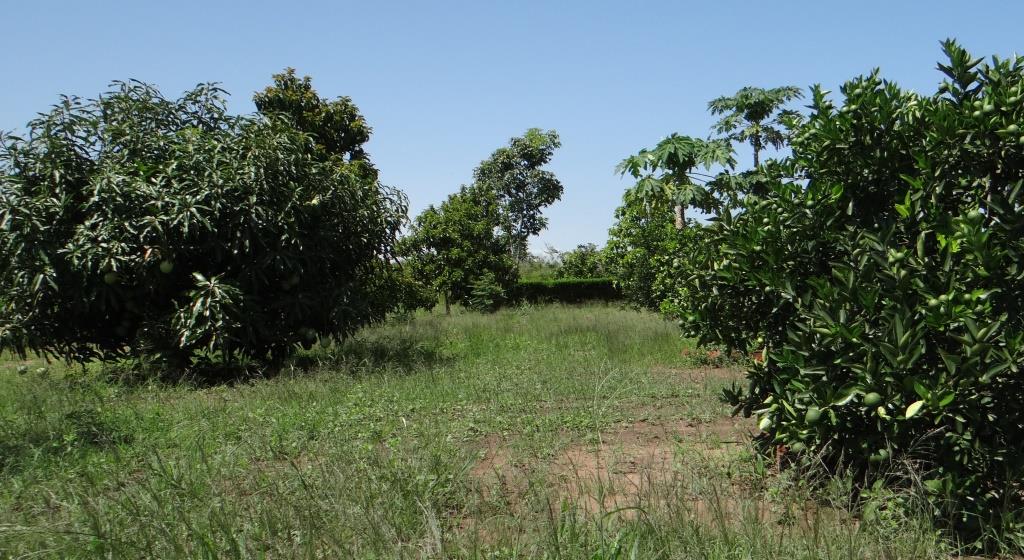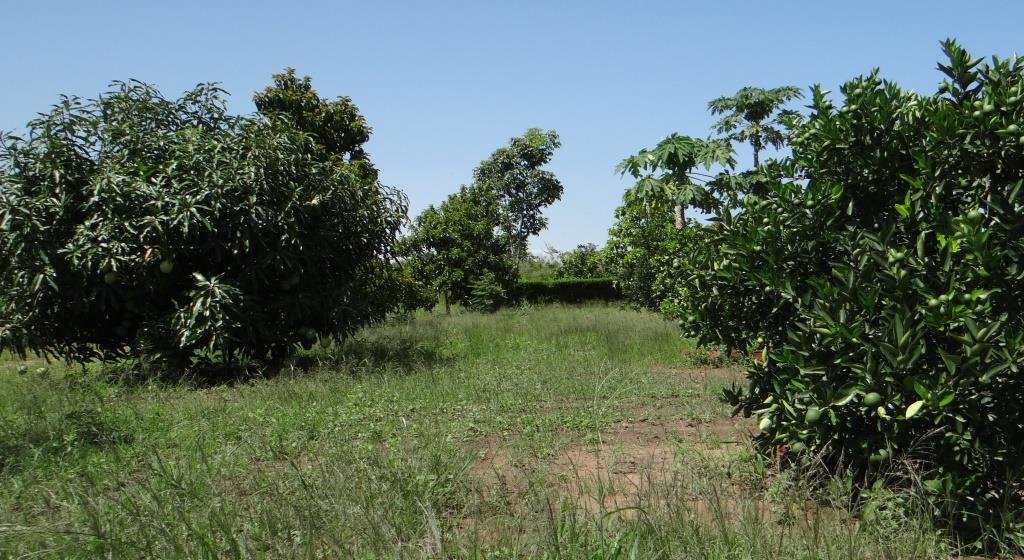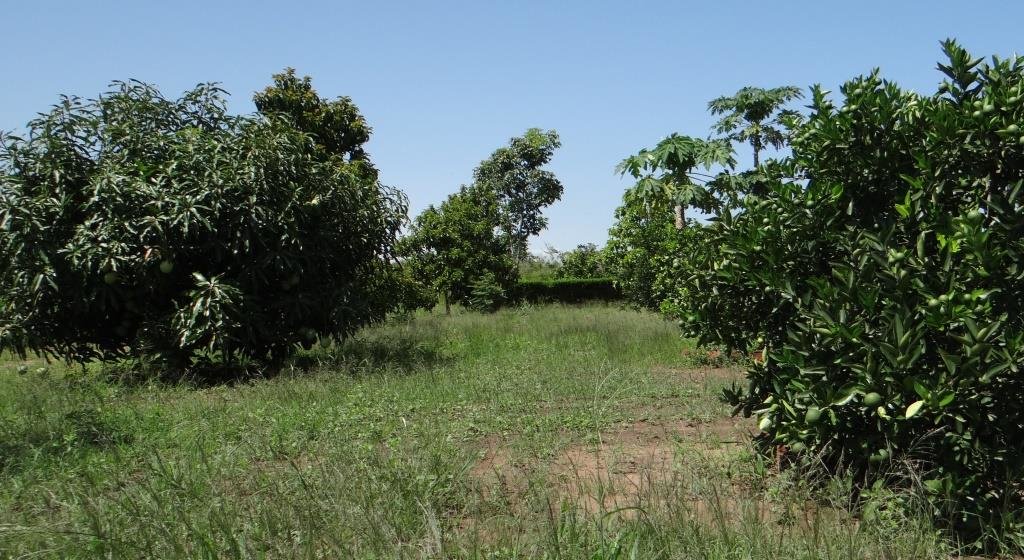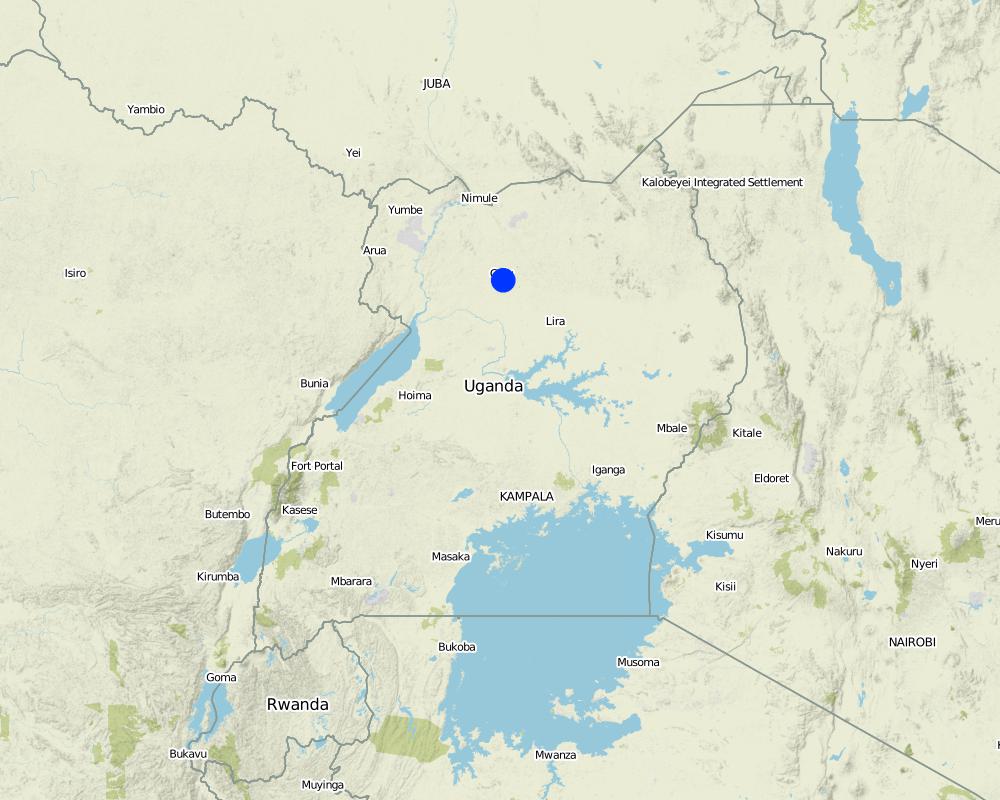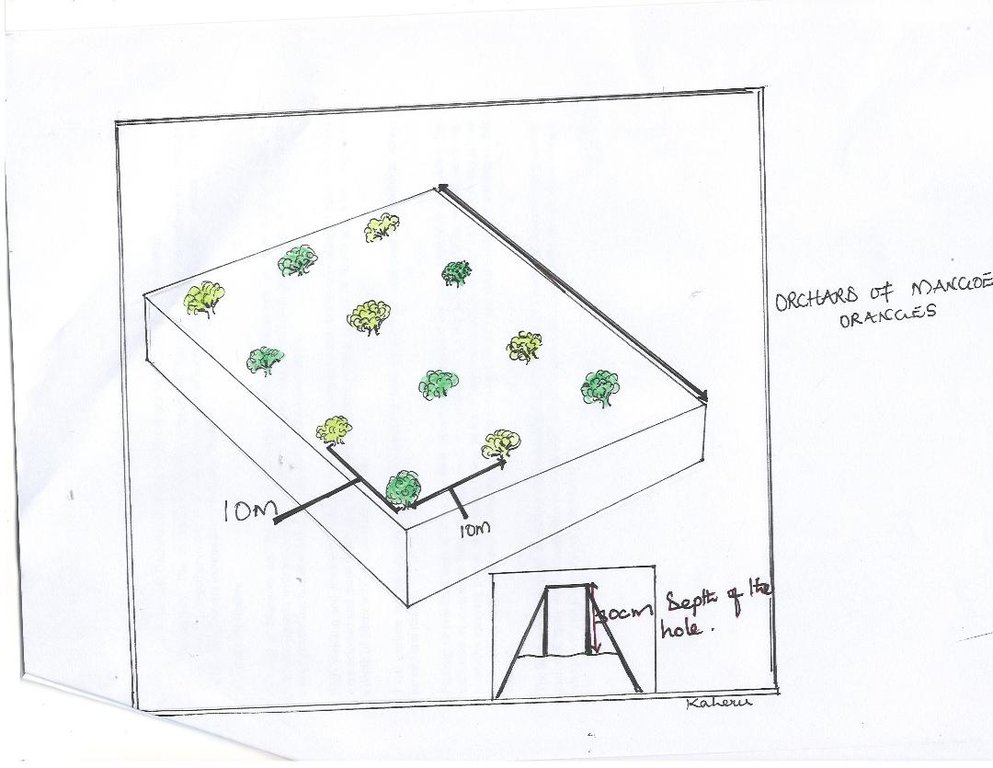Orchard of Mangoes and Oranges for Soil Fertility Improvement. [乌干达]
- 创建:
- 更新:
- 编制者: Kamugisha Rick Nelson
- 编辑者: JOY TUKAHIRWA, Richard Otto Kawawa, Sunday Balla Amale, Bernard Fungo
- 审查者: John Stephen Tenywa, Nicole Harari, Renate Fleiner, Stephanie Jaquet, Donia Mühlematter
Muyembe na mucungwa
technologies_2817 - 乌干达
查看章节
全部展开 全部收起1. 一般信息
1.2 参与该技术评估和文件编制的资源人员和机构的联系方式
关键资源人
土地使用者:
Walter Oduour
0775296773
Gulu Development association
Gulu District
乌干达
有助于对技术进行记录/评估的项目名称(如相关)
Scaling-up SLM practices by smallholder farmers (IFAD)有助于对技术进行记录/评估的机构名称(如相关)
CDE Centre for Development and Environment (CDE Centre for Development and Environment) - 瑞士1.3 关于使用通过WOCAT记录的数据的条件
(现场)数据是什么时候汇编的?:
26/05/2017
编制者和关键资源人员接受有关使用通过WOCAT记录数据的条件。:
是
1.4 所述技术的可持续性声明
这里所描述的技术在土地退化方面是否存在问题,导致无法被认为是一种可持续的土地管理技术?:
否
2. SLM技术的说明
2.1 技术简介
技术定义:
The technology involves growing of Mangoes (Mangifera indica) and Oranges (Citrus sinensis) in the same field with the aim of conserving the environment, protecting soil from erosion, and generating income from the sale of fruits.
2.2 技术的详细说明
说明:
Growing mangoes and oranges in the same field is a common sustainable land management cropping system practiced by farmers in Northern Uganda for soil fertility improvement. Under this practice farmer benefit from the litter of leaves when they fall and decompose to form manure to increase fertility of the soil. A farm located on a gentle slope of 3-5 % measuring an average size of 2-5 acres, is planted with orange varieties (Valencia and Hamlin) and mango varieties (Apple and Tommy) with the aim of generating household income and improving soil fertility litter and decomposition of the fallen leaves. The mango and orange seedlings are planted at a spacing of 10 m × 10 m in holes dug down to a depth of 30cm.
Seven to 10 workers are paid on a monthly basis and their day to day activities include establishing and maintaining the orchard; establishment entails slashing the field, digging the holes, and planting the seedlings, while maintenance entails spraying pests which attack the mangoes and oranges harvesting and marketing.
Planting more than one fruit trees in the same field increases saves use of more land which would be used for planting two fruit trees in separate gardens and saves labor since all the fruit trees are located and grown in one same field. Which in turn saves labour that would be used on two different fields. However, it is important for farmers to know that high costs are encountered at the beginning; this costs include buying seedlings, hoes, pangs, pesticides, spray pumps, and paying for labour. The costs are expected to reduce over time, leaving only costs of labour for weeding, monitoring, harvesting and marketing.
It is important for the land user to be aware that this technology is easily affected by pests and diseases. To control pests and disease, it is recommended to use dimethoiate, sprayed once every after 3 to 7 weeks.
2.3 技术照片
2.4 技术视频
注释、简短说明:
Video on Orchard of Mangoes and Oranges for soil fertility Improvement in Gulu District, Northern Uganda.
日期:
26/05/2017
位置:
Gulu District
2.5 已应用该技术的、本评估所涵盖的国家/地区/地点
国家:
乌干达
区域/州/省:
Northern Region,Uganda
有关地点的进一步说明:
Gulu Municipality, Gulu District
注释:
Map showing technology site of Mangoes (Mangifera indica) and Oranges (Citrus sinensis) for soil fertility Improvement.
Map
×2.6 实施日期
注明实施年份:
2012
如果不知道确切的年份,请说明大概的日期:
- 不到10年前(最近)
2.7 技术介绍
详细说明该技术是如何引入的:
- 通过项目/外部干预
注释(项目类型等):
Operation Wealth Creation (OWC) supported the farmer with seedlings.
3. SLM技术的分类
3.1 该技术的主要目的
- 改良生产
- 减少、预防、恢复土地退化
- 减缓气候变化及其影响
- 创造有益的经济影响
3.2 应用该技术的当前土地利用类型

农田
- 一年一作
主要农作物(经济作物及粮食作物):
Maize and banana.

混合(作物/放牧/树木),包括农林
- 农林业
主要产品/服务:
Banana.
3.3 有关土地利用的更多信息
该技术所应用土地的供水:
- 雨养
每年的生长季节数:
- 2
3.4 该技术所属的SLM组
- 农业林学
- 土壤肥力综合管理
- 改良植物品种/动物品种
3.5 技术传播
具体说明该技术的分布:
- 均匀地分布在一个区域
如果该技术均匀地分布在一个区域上,请注明覆盖的大致区域。:
- < 0.1 平方千米(10 公顷)
3.6 包含该技术的可持续土地管理措施

农艺措施
- A1:植被和土壤覆盖层
- A2:有机质/土壤肥力
- A3:土壤表面处理
- A5:种子管理,改良品种

结构措施
- S11:其它

管理措施
- M1:改变土地使用类型
- M2:改变管理/强度级别
- M4:活动时间安排的重大变化
注释:
S11-Holes where mangoes and oranges are planted.
3.7 该技术强调的主要土地退化类型

土壤水蚀
- Wt:表土流失/地表侵蚀

土壤风蚀
- Et:表土流失

化学性土壤退化
- Cn:肥力下降和有机质含量下降(非侵蚀所致)

生物性退化
- Bc:植被覆盖的减少
- Bs:质量和物种组成/多样性的下降
- Bp:害虫/疾病增加,捕食者减少

水质恶化
3.8 防止、减少或恢复土地退化
具体数量名该技术与土地退化有关的目标:
- 防止土地退化
- 减少土地退化
4. 技术规范、实施活动、投入和成本
4.1 该技术的技术图纸
4.2 技术规范/技术图纸说明
The technical drawing shows a fruit tree farm located on a gentle slope of 3-5 % measuring an average size of 2-5 acres planted with high yielding and marketable orange varieties (Valencia and Hamlin) and mango varieties (Apple and Tommy) with the aim of generating household income and improving soil fertility. The mango and orange seedlings are planted at a spacing of 10 m × 10 m in holes dug down to a depth of 30 cm supported by seven to 10 workers who are paid on a monthly basis to support establishment and management activities.
4.3 有关投入和成本计算的一般信息
具体说明成本和投入是如何计算的:
- 每个技术区域
其它/国家货币(具体说明):
UGX
注明美元与当地货币的汇率(如相关):1美元=:
3400.0
注明雇用劳工的每日平均工资成本:
5000
4.4 技术建立活动
| 活动 | 措施类型 | 时间 | |
|---|---|---|---|
| 1. | Site / field selection | 农业学的 | Once before establishment |
| 2. | Slashing the field | 植物性的 | Once before establishment |
| 3. | Look for labour | 其它措施 | Before establishment |
| 4. | Select for seedlings | 农业学的 | Before establishment |
| 5. | Dig the hole | 结构性的 | During establishment |
| 6. | Plant the seedlings | 农业学的 | Before estabslishment |
| 7. | 管理 | After establishment |
4.5 技术建立所需要的费用和投入
| 对投入进行具体说明 | 单位 | 数量 | 单位成本 | 每项投入的总成本 | 土地使用者承担的成本% | |
|---|---|---|---|---|---|---|
| 劳动力 | Persons days on monthly basis | Persons | 8.0 | 100000.0 | 800000.0 | 100.0 |
| 设备 | Hoes | Pieces | 4.0 | 10000.0 | 40000.0 | 100.0 |
| 设备 | Pangas | Pieces | 4.0 | 7000.0 | 28000.0 | |
| 设备 | Spraying pumps | Pieces | 2.0 | 250000.0 | 500000.0 | |
| 植物材料 | Seedlings | seedling | 1000.0 | 2500.0 | 2500000.0 | |
| 肥料和杀菌剂 | Pestcides | litres | 3.0 | 10000.0 | 30000.0 | 100.0 |
| 施工材料 | 100.0 | |||||
| 技术建立所需总成本 | 3898000.0 | |||||
4.6 维护/经常性活动
| 活动 | 措施类型 | 时间/频率 | |
|---|---|---|---|
| 1. | Slashing | 农业学的 | Twice a year |
4.7 维护/经常性活动所需要的费用和投入(每年)
| 对投入进行具体说明 | 单位 | 数量 | 单位成本 | 每项投入的总成本 | 土地使用者承担的成本% | |
|---|---|---|---|---|---|---|
| 劳动力 | Persons days on monthly basis | Persons | 2.0 | 100000.0 | 200000.0 | 100.0 |
| 劳动力 | labour for weeding daily basis | Persons | 2.0 | 5000.0 | 10000.0 | 100.0 |
| 肥料和杀菌剂 | Pestcide | Litres | 4.0 | 13000.0 | 52000.0 | |
| 技术维护所需总成本 | 262000.0 | |||||
4.8 影响成本的最重要因素
描述影响成本的最决定性因素:
Labour for planting, weeding , slashing and spraying take the most costs.
5. 自然和人文环境
5.1 气候
年降雨量
- < 250毫米
- 251-500毫米
- 501-750毫米
- 751-1,000毫米
- 1,001-1,500毫米
- 1,501-2,000毫米
- 2,001-3,000毫米
- 3,001-4,000毫米
- > 4,000毫米
指定年平均降雨量(若已知),单位为mm:
1400.00
有关降雨的规范/注释:
Two rainy season (March- may) and September to November.
农业气候带
- 半湿润
5.2 地形
平均坡度:
- 水平(0-2%)
- 缓降(3-5%)
- 平缓(6-10%)
- 滚坡(11-15%)
- 崎岖(16-30%)
- 陡峭(31-60%)
- 非常陡峭(>60%)
地形:
- 高原/平原
- 山脊
- 山坡
- 山地斜坡
- 麓坡
- 谷底
垂直分布带:
- 0-100 m a.s.l.
- 101-500 m a.s.l.
- 501-1,000 m a.s.l.
- 1,001-1,500 m a.s.l.
- 1,501-2,000 m a.s.l.
- 2,001-2,500 m a.s.l.
- 2,501-3,000 m a.s.l.
- 3,001-4,000 m a.s.l.
- > 4,000 m a.s.l.
说明该技术是否专门应用于:
- 不相关
5.3 土壤
平均土层深度:
- 非常浅(0-20厘米)
- 浅(21-50厘米)
- 中等深度(51-80厘米)
- 深(81-120厘米)
- 非常深(> 120厘米)
土壤质地(表土):
- 粗粒/轻(砂质)
- 中粒(壤土、粉土)
土壤质地(地表以下> 20厘米):
- 粗粒/轻(砂质)
- 中粒(壤土、粉土)
表土有机质:
- 高(>3%)
- 中(1-3%)
如有可能,附上完整的土壤描述或具体说明可用的信息,例如土壤类型、土壤酸碱度、阳离子交换能力、氮、盐度等。:
Top soil organic matter is high due to because when leaves litter they rot and decompose and form manure which improves fertility , and sometimes when oranges and mangoes fall on the ground and are not picked by the farmer due to high production, they rot and decompose and improve the organic matter.
5.4 水资源可用性和质量
地下水位表:
< 5米
地表水的可用性:
中等
水质(未处理):
良好饮用水
水的盐度有问题吗?:
否
该区域正在发生洪水吗?:
否
5.5 生物多样性
物种多样性:
- 中等
栖息地多样性:
- 中等
5.6 应用该技术的土地使用者的特征
定栖或游牧:
- 定栖的
生产系统的市场定位:
- 商业/市场
非农收入:
- 低于全部收入的10%
相对财富水平:
- 平均水平
个人或集体:
- 个人/家庭
机械化水平:
- 手工作业
- 机械化/电动
性别:
- 女人
- 男人
土地使用者的年龄:
- 青年人
- 中年人
5.7 应用该技术的土地使用者拥有或租用的平均土地面积
- < 0.5 公顷
- 0.5-1 公顷
- 1-2 公顷
- 2-5公顷
- 5-15公顷
- 15-50公顷
- 50-100公顷
- 100-500公顷
- 500-1,000公顷
- 1,000-10,000公顷
- > 10,000公顷
这被认为是小规模、中规模还是大规模的(参照当地实际情况)?:
- 中等规模的
5.8 土地所有权、土地使用权和水使用权
土地所有权:
- 个人,未命名
土地使用权:
- 个人
用水权:
- 个人
5.9 进入服务和基础设施的通道
健康:
- 贫瘠
- 适度的
- 好
教育:
- 贫瘠
- 适度的
- 好
技术援助:
- 贫瘠
- 适度的
- 好
就业(例如非农):
- 贫瘠
- 适度的
- 好
市场:
- 贫瘠
- 适度的
- 好
能源:
- 贫瘠
- 适度的
- 好
道路和交通:
- 贫瘠
- 适度的
- 好
饮用水和卫生设施:
- 贫瘠
- 适度的
- 好
金融服务:
- 贫瘠
- 适度的
- 好
6. 影响和结论性说明
6.1 该技术的现场影响
社会经济效应
生产
作物生产
作物质量
土地管理
收入和成本
农业投入费用
注释/具体说明:
High due to purchase seedlings, labour, fertilizer costs during the short run but reducing in the long run.
农业收入
注释/具体说明:
From the sale of mangoes and oranges.
工作量
社会文化影响
SLM/土地退化知识
6.2 该技术的场外影响已经显现
水资源可用性
6.3 技术对渐变气候以及与气候相关的极端情况/灾害的暴露和敏感性(土地使用者认为的极端情况/灾害)
渐变气候
渐变气候
| 季节 | 气候变化/极端天气的类型 | 该技术是如何应对的? | |
|---|---|---|---|
| 年温度 | 增加 | 适度 | |
| 季节性温度 | 湿季/雨季 | 减少 | 适度 |
| 年降雨量 | 增加 | 好 | |
| 季雨量 | 湿季/雨季 | 增加 | 适度 |
气候有关的极端情况(灾害)
气候灾害
| 该技术是如何应对的? | |
|---|---|
| 陆地火灾 | 不好 |
水文灾害
| 该技术是如何应对的? | |
|---|---|
| 滑坡 | 好 |
注释:
Growing of mangoes and oranges in the field can be affected by fire outbreaks and good at reducing erosion and land slides.
6.4 成本效益分析
技术收益与技术建立成本相比如何(从土地使用者的角度看)?
短期回报:
稍微积极
长期回报:
积极
技术收益与技术维护成本/经常性成本相比如何(从土地使用者的角度看)?
短期回报:
非常积极
长期回报:
非常积极
6.5 技术采用
- 1-10%
在所有采用这项技术的人当中,有多少人是自发地采用该技术,即未获得任何物质奖励/付款?:
- 0-10%
注释:
More land users are interested in the technology but capital to buy seedlings is a problem.
6.6 适应
最近是否对该技术进行了修改以适应不断变化的条件?:
否
6.7 该技术的优点/长处/机会
| 土地使用者眼中的长处/优势/机会 |
|---|
| East to manage on farm. |
| Cost effective: Returns are high if managed well. |
| Controls soil erosion; Good at reducing soil erosion. |
| Creates employment for many people and it is good at providing income after sale of fruits. |
| 编制者或其他关键资源人员认为的长处/优势/机会 |
|---|
| Its replicable; it can be used by both small and large scale land users. |
6.8 技术的弱点/缺点/风险及其克服方法
| 土地使用者认为的弱点/缺点/风险 | 如何克服它们? |
|---|---|
| Appropriate to the rich only; Inputs are expensive. | Link the small scale land users to credit institutions with less interest rates to pay back later after selling their products. |
| 编制者或其他关键资源人员认为的弱点/缺点/风险 | 如何克服它们? |
|---|---|
| Risky in case of pests and diseases; Low returns-low income. | On site training in pests and disease management. |
7. 参考和链接
7.1 信息的方法/来源
- 实地考察、实地调查
1
- 与土地使用者的访谈
1
链接和模块
全部展开 全部收起链接
无链接
模块
无模块


